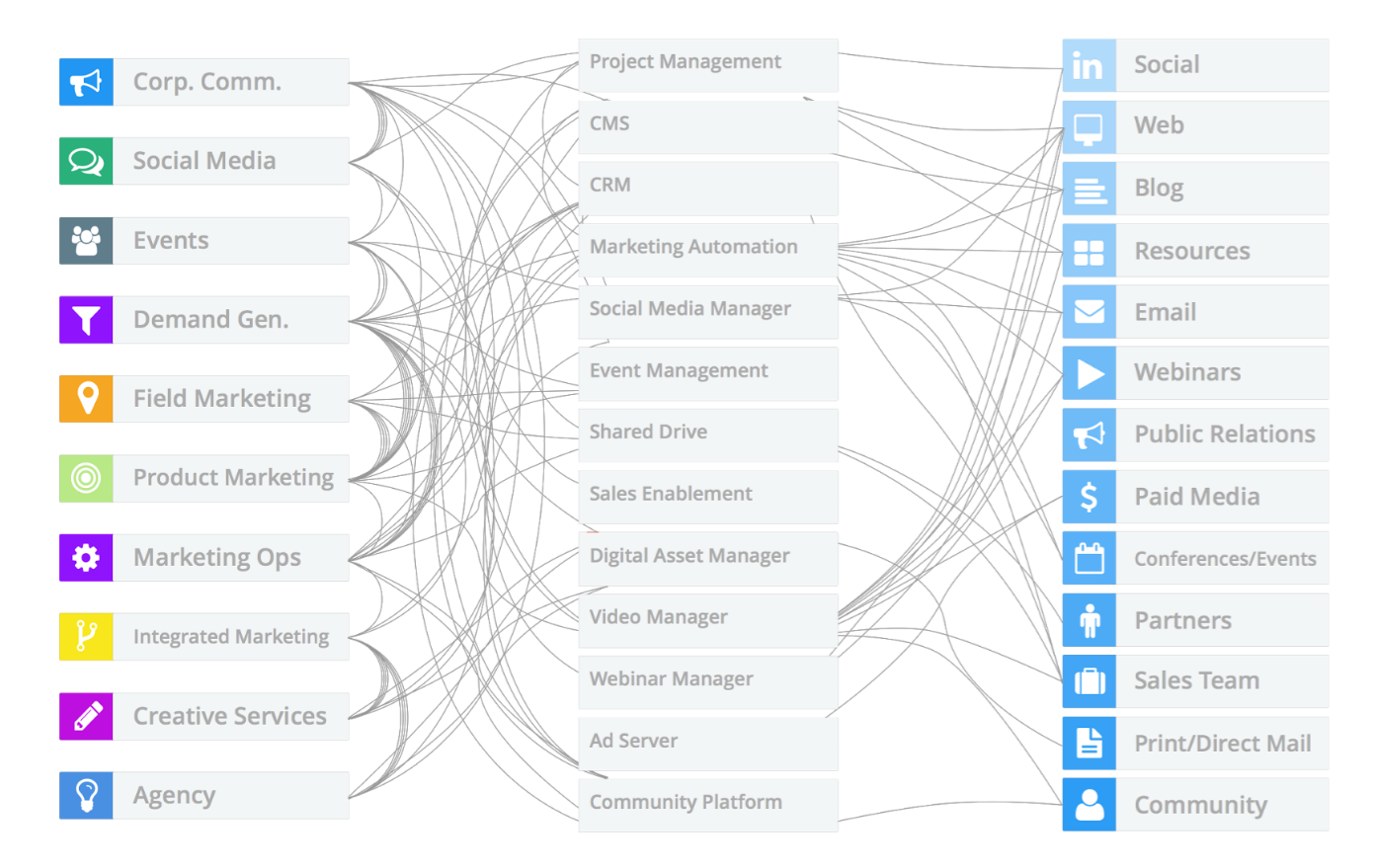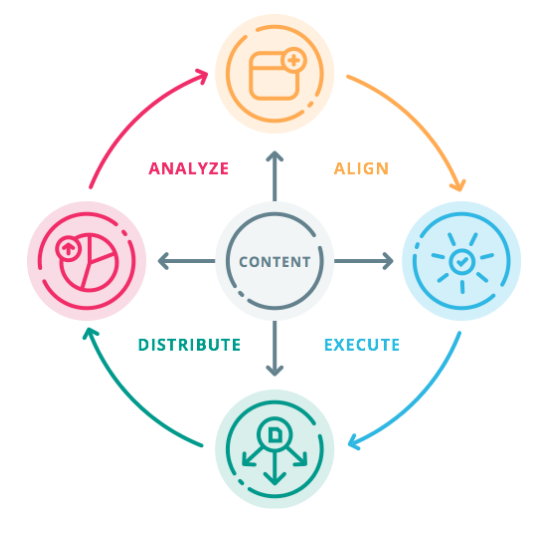Marketing is not the same function it was ten years ago—when B2B marketers were considered “sales support.” Today, we hold our place as an equal partner among various corporate functions, including equal accountability to deliver tangible business results.
The digital revolution catalyzed the transformation of B2B marketing from cost-center to profit-center. Changes in the buyer’s journey have driven marketing teams to step up and take ownership of the entire funnel. In the course of adjusting to the digital age, we’ve changed three key dimensions:
-
Teams: Marketing used to operate with a few teams, say corporate communications and product marketing, along with external agency support. Now, most marketing organizations do the majority of work internally rather than through agencies across specialized teams (social, demand gen, etc.).
-
Tools: 10 years ago, we were just beginning to experiment with email marketing tools. Now, a typical marketing organization employs dozens of tools, from marketing automation, to web analytics, social media management…the list goes on and on.
-
Channels: Again, in the recent past, marketing focused on the sales channel, ads, and events. Now, mature B2B Marketing orgs manage an ever-growing set of channels including: blog, video, a multitude of social platforms, webinars, etc.

But while marketing has focused on the responsibility to deliver revenue-driven results, it has had little time to investigate how to manage marketing amidst the clutter of teams, tools, and channels. In fact looking across the corporate landscape, we seems to be the most neglected department.
The One Department Without an Operating System
Business information technology applications can be broadly divided into two groups: point solutions that solve a specific issue and operating systems (or “OS”) that coordinate many functions. An example of a point solution would be web chat software for customer support. However, an OS servers a much broader function.
An OS within computer systems is defined as:
The operating system controls your computer’s tasks and manages system resources to optimize performance.
For business technology, an OS serves a similar purpose:
The operating system application category controls your department’s tasks and manages departmental resources to optimize performance
Thus, internal activity is mapped out within the system. Executive leaders can set strategy, monitor progress, and measure performance through a single system, while the wider team uses the system to coordinate and execute.
Nearly every department has such an OS:
-
Sales: CRM, sometimes referred to as Sales Force Automation; Salesforce.com is the dominant player, along with Microsoft, Sugar, and Oracle
-
Product & Engineering: Project Portfolio Management, like Jira / Atlassian, Rally, Workfront, Pivotal, and Planview
-
Customer Support: Run through systems like Zendesk, Desk.com / Salesforce, Oracle
-
Human Resources: Managed using systems like Workday, SAP / Successfactors, and Oracle / Taleo.
-
Finance & Accounting: ERP systems like NetSuite, Xero, SAP, or Oracle.
-
Customer Success: A relatively new function with new OSs including Gainsight, Totango, ClientSuccess, and Preact.
Every department has an OS that manages the work of their team and their function. Every department, that is, besides marketing.
Now the folks behind marketing automation would beg to differ. However, marketing automation really does two things:
-
Runs your email channel
-
Manages lead scoring
The first function is entirely tactical. The second is quite strategic. Marketing automation is the system of record for leads: it holds data on who they are, what they’ve done, and where they stand in the buyer’s journey. This lead management functionality, however, should not mistake marketing automation for being an OS.
The various OSs listed above are utilized by 60% of a department on a daily basis. Can marketing automation make that claim? Perhaps 10%, maybe 20%, of the marketing team regularly logs into marketing automation software—it’s simply not the system that organizes marketing’s work.
Now Is the Time for a Marketing-Specific OS
Just like the other departments, we, as marketing organizations, need to utilize an OS—a system purpose-built for specific marketing needs. Out of desperation, some marketers have tried using IT project management tools or Salesforce functionality. But such efforts have the same odds of success as finance implementing Workday or customer support implementing NetSuite.
We need an OS designed to serve the marketing function. And this is where content comes in.
Increasingly, marketing experts acknowledge content as the core activity across the marketing function:
-
SiriusDecisions calls content “the lifeblood of Marketing” and “the backbone of Marketing”
-
Altimeter calls content “the atomic particle of Marketing”
-
Accenture calls content “Marketing’s most vital resource, the water of Marketing”
-
And Gartner calls content “the coin of the marketer’s realm, the currency of trade”
Content is what flows between the proliferation of teams, tools, and channels that marketing must manage. Content critically carries the message across the customer journey. And content represents the lion’s share of marketing activity—from demand generation nurture tracks to product marketing guides.
Content as the Foundation of the Marketing Operating System: The Four Stage Cycle
Content, in its broad definition, is what marketing does. And so the Marketing Operating System ought to have content at its foundation, providing the necessary, marketing-specific functionality at every stage of the content lifecycle: align, execute, distribute, analyze.

Align
Here, marketing teams come together on a set of strategic initiatives to pursue and plan out how they will execute on those initiatives. A Marketing Operating System (or “MOS”) needs to be able to provide visibility into marketing’s complex planning in multiple ways, providing all stakeholders necessary insight.
Execute
In the execute stage, we turn our plans to produce initiatives and content into action and output. An MOS must manage the work of all of the various content types like blog posts, videos, documents, sales decks, emails, or even in-person events. And an MOS must enable collaboration and accountability across far-ranging, often cross-functional teams, through editing, notifications, and workflow tools.
Distribute
At the distribute stage, marketing teams send finished work into the tools and channels where it can connect with the customer. Thus, an MOS must integrate with various tools and channels, including:
-
Social / Social Media Management Systems
-
Web & Blog / Content Management Systems
-
Sales / Sales Asset Management & CRM Systems
-
Video / Video Marketing Management
-
Email / Marketing Automation
-
Events / Event Marketing Management
Additionally, an MOS must provide an internal content repository for internal consumers to easily find and use relevant, up-to-date content.
Analysis
During the analysis stage, we need to measure all distributed content to gain insight and refine strategy. Thus, an MOS must be able to measure all content types in a uniform, consistent way. Additionally, content should be measured based on more than mere consumption, showing thematic patterns, which successfully moves prospects down the funnel.
Takeaway
Marketers deserve better and are asking for more than the status quo: a true Marketing Operating System to manage B2B content through every stage of the content lifecycle and the aggregate view that marketing leaders need to see the plans and progress of their department.
This is what truly elevates Kapost to the OS status and allows every marketing function, from marketing ops to content creators to CMOs, to escape the chaos of operational details and focus on doing more of what they love: being world-class B2B marketers.
